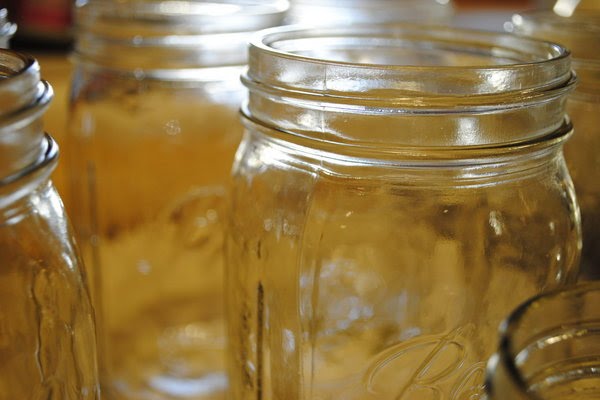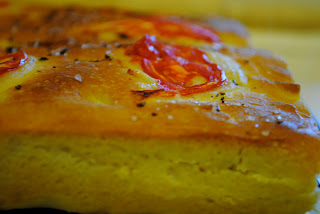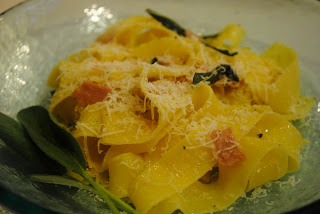It doesn't even matter if it something simple, like making the vinaigrette for a salad from scratch; sometimes all it really takes is just the mindless act of chopping ingredients on a cutting board, or stirring a pot of something bubbling away at the stove, that makes me smile.
Whatever it is, the kitchen never fails to make me feel better. Growing up with a younger brother who was handicapped, my family had its fair share of heartache. But I've never been one of those people who looks back on their childhood as a bad one. It wasn't all that bad, just unstable; to the point where constant change and adapting became normal to me, like breathing.
Whatever it is, the kitchen never fails to make me feel better. Growing up with a younger brother who was handicapped, my family had its fair share of heartache. But I've never been one of those people who looks back on their childhood as a bad one. It wasn't all that bad, just unstable; to the point where constant change and adapting became normal to me, like breathing.
So maybe that's why, from a young age, I fell in love with baking. The precise measuring of ingredients; the smell of something deliciously sweet or savory that permeated from the oven. I loved it all. Mostly, I loved the predictability of it; that I could start off by just reading the instructions for a recipe, and by the time I was whisking ingredients together, or spooning dough into rounds on a cookie sheet, I could transport myself to a different place. A place where, by following a few simple directions, butter, sugar and flour could produce something as consistant and wonderful as strawberry shortcake.
Today, when I cook in my kitchen, I don't just bake; I boil and roast and fry and saute and blend. I whisk and caramelize and knead and stir. I don't have to follow a recipe's instructions as often as I used to, and sometimes I make up my own. But there's one thing that hasn't changed since I was that little girl, standing in my parent's kitchen, trying to make sense of my life by way of chocolate chip cookies. What hasn't changed is that cooking, no matter what form it takes on, still has the power to transform me, or the people I love, even on the hardest of days.
I'm not that little girl any longer, and I've become a much better cook than I was then. But that doesn't mean that I've forgotten who I was, or where I've come from. Each time that I sit down to eat on my grandmother's wooden dining table, or churn sorbet in my mother's old Kitchenaid Ice Cream maker, I take my family with me. The memories, good and bad, make up the woman that I am today, like the many layers that make up the dishes I create in my kitchen.
I cook, because it makes me happy, and it makes other people happy. We all have different ways in which we deal with the stress or pain in our daily lives. For some people, it's a glass of whiskey or wine at the end of a long day- or yoga, or running, and that's just fine. For me, I choose to cook in my kitchen. The pots and pans, the wooden spoons and measuring cups- the way it makes not just me, but anyone, smile when they eat something that tastes delicious.
Like me, both of my brothers share a love for food. My older brother, Steve, was a restaurant chef for many years, and my younger brother, Michael- well he loves anything you put in front of him, especially if it's laced in ketchup. I like to think that it's something we share as siblings, a tiny invisible string that links us together.
They're who I am thinking of today, while I wait for my Roma tomatoes and Italian sausages to finish roasting in their juices with rosemary, thyme and olive oil. I can feel my bad mood begin to lift already. I'll smile when I taste the caramelized onions and garlic, whose flavor has mellowed and sweetened during their time in the oven- the perfect balance to the acidity of the tomatoes and the richness of the meat. And I'll smile because of that little girl in her parent's kitchen, trying to make sense of the world with her mother's cookbook, her grandmother's green pyrex mixing bowl, and an oven.
Roasted Roma Tomatoes and Italian Sausage
Yields enough for two hearty servings (but can be doubled very easily to accommodate more)
A Note:
This is the kind of recipe that will put anyone in a better mood, no matter who they are. It's mindless cooking, but comforting, and the most rewarding dish to to eat. You can serve it with big hunks of toasted bread, or just eat it straight from the refrigerator with a knife and fork, which is exactly what John and I did. It's also fabulous the next day, chopped up and tossed with any kind of pasta.
Ingredients:
Roasted Roma Tomatoes and Italian Sausage
Yields enough for two hearty servings (but can be doubled very easily to accommodate more)
A Note:
This is the kind of recipe that will put anyone in a better mood, no matter who they are. It's mindless cooking, but comforting, and the most rewarding dish to to eat. You can serve it with big hunks of toasted bread, or just eat it straight from the refrigerator with a knife and fork, which is exactly what John and I did. It's also fabulous the next day, chopped up and tossed with any kind of pasta.
Ingredients:
- Four good quality Italian sausages (we used "hot Italian", but any Italian type will do)
- 8 Roma tomatoes
- One large cippolini onion, thinly sliced (or any other kind of yellow variety)
- Five garlic cloves, peeled and smashed
- a sprig or two of rosemary
- a sprig of thyme
- 1-2 bay leaves
- extra-virgin olive oil
- a few small glugs of good quality balsamic vinegar
- kosher salt and freshly ground black pepper
- Preheat oven to 375 degrees.
- Layer the sliced onions and garlic on the bottom of a large baking/roasting tray.
- Drizzle a decent amount of olive oil into the pan, enough to decently cover the onions and garlic with oil. Sprinkle with salt and pepper.
- Place pan in the oven, and let the onions and garlic caramelize, about 15 minutes.
- Remove from oven and add roma tomatoes, herbs and sausage to the pan. Sprinkle with a bit more salt and pepper and drizzle a tiny bit more olive oil, if desired. Toss everything together to coat with oil.
- Roast in the oven for 30 minutes.
- Turn sausage over on other side, and pour a few glugs of balsamic vinegar over everything. Roast for another 20-40 minutes, depending on how browned you like your sausage.
- Check seasoning, and serve on its own- or even better- with big hunks of toasty bread.











































